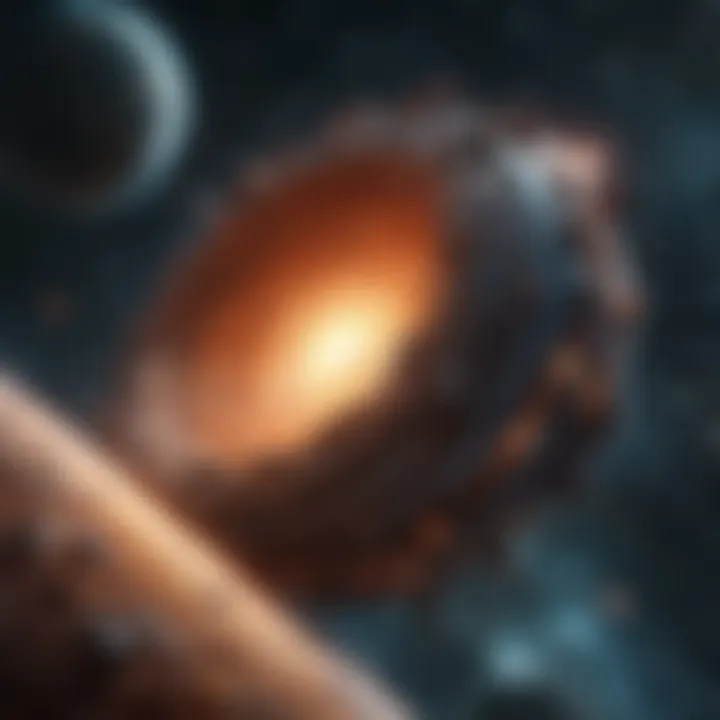Current Trends and Discoveries in Astronomy


Article Overview
Purpose of the Article
This article aims to dissect the contemporary landscape of astronomy. By highlighting significant discoveries and technological advancements, it seeks to illustrate how these developments deepen our understanding of the universe. Furthermore, it will delve into the collaborative efforts among international research communities, showcasing their crucial role in pushing the boundaries of astronomical research.
Relevance to Multiple Disciplines
Astronomy intersects with various fields, including physics, engineering, and environmental science. For instance, the development of advanced telescopes requires knowledge of optics and materials science. Additionally, understanding cosmic phenomena can influence our approaches to climate change on Earth. By integrating insights from these disciplines, the article will present a holistic view of astronomy's evolving role in science.
Research Background
Historical Context
Astronomy has a rich history, dating back to ancient civilizations. Early astronomers used simple tools to observe celestial bodies, laying the groundwork for modern astrophysics. However, with the dawn of the telescope in the 17th century, the discipline began to shift dramatically. This shift marked the transition from qualitative to quantitative study, paving the way for significant discoveries such as the heliocentric model and the understanding of planetary motion.
Key Concepts and Definitions
To comprehend the current trends in astronomy, it is essential to define a few key concepts:
- Exoplanets: Planets outside our solar system that orbit stars. The discovery of exoplanets has opened new questions about planetary systems and life beyond Earth.
- Dark Matter: A form of matter that does not emit light or energy, making it invisible and detectable only through its gravitational effects on visible matter.
- Gravitational Waves: Ripples in spacetime caused by the acceleration of massive objects, providing a new way to observe the universe.
Understanding these terms provides a foundation for discussing the latest findings and technological strides in astronomy.
"Astronomy compels the soul to look upwards and leads us from this world to another." — Plato
"Astronomy compels the soul to look upwards and leads us from this world to another." — Plato
These ideas will shape the discussion throughout the article, illustrating how they connect to advances being made today.
Recent Discoveries in Astronomy
Recent discoveries in astronomy have brought significant advancements to our understanding of the universe. Each discovery not only expands our knowledge but also raises intriguing questions about the cosmos. The exploration of exoplanets and gravitational waves stands out as two critical areas of recent research. Both fields are witnessing innovations that attract interest from scientists and the public alike. These discoveries capture the essence of modern astronomy's quest to unveil the mysteries of existence beyond Earth.
Exoplanet Research
Newly Discovered Exoplanets
Newly discovered exoplanets represent one of the most exhilarating aspects of current astronomical research. Thousands of these worlds have been identified, with some exhibiting characteristics that resemble Earth. Each exoplanet discovery adds to our understanding of the formation and evolution of planetary systems. For instance, TOI 700 d is an Earth-sized planet located in the habitable zone of its star, which raises questions about potential life. These findings encourage further studies in planetary atmospheres, surface conditions, and potential biosignatures.
Characterization Techniques
Characterization techniques have advanced considerably, enabling astronomers to analyze exoplanets in depth. Methods such as transmission spectroscopy allow scientists to study exoplanet atmospheres by observing the light that passes through them. This technique has revealed the presence of critical components like water vapor and the potential for clouds. The versatility of these techniques makes them essential for determining the makeup of distant worlds, pushing the boundaries of what we know about other planetary systems.
Potential for Habitability
The potential for habitability is a critical aspect of exoplanet research. Scientists assess factors like distance from the host star, atmospheric composition, and geological activity to evaluate whether these planets could support life. The Kepler Space Telescope's data indicated that a significant number of stars have Earth-sized planets in their habitable zones. This realization points to the possibility that we are not alone in the universe, making the search for extraterrestrial life a compelling area of study.
Gravitational Wave Astronomy
Recent Events Detected
The detection of recent gravitational wave events marks a transformative shift in our understanding of astrophysical phenomena. Observatories such as LIGO and Virgo have successfully recorded collisions between black holes and neutron stars. These events provide direct evidence of the existence of these exotic objects and expand our knowledge of the early universe. Furthermore, such discoveries help in tracing cosmic events back to their origins, offering an unprecedented glimpse into the fabric of spacetime.
Implications for Cosmology
Gravitational waves have profound implications for cosmology. They allow scientists to test theories regarding the expansion of the universe and the nature of its most enigmatic components. These waves act as messengers from the distant past, helping astronomers gather information about the early moments after the Big Bang. The synergy between gravitational wave astronomy and traditional light-based astronomy is expected to unravel more secrets about dark matter and energy, thus reshaping our understanding of the universe's structure.
Future Observations
Looking ahead, future observations in gravitational wave astronomy promise to deepen our insights significantly. The introduction of new detectors like the space-based LISA will increase sensitivity and open new avenues for exploring the universe. Researchers expect to detect waves from sources that are currently beyond our reach, potentially leading to breakthroughs in our understanding of cosmic explosions and the merger of massive objects. The future of gravitational wave astronomy is poised to redefine celestial studies, driving home the relevance of these phenomena in astronomical exploration.
Technological Advancements in Astronomy
Technological advancements play a crucial role in astronomy. They enhance our ability to observe, analyze, and interpret astronomical data. As the universe expands in complexity, these innovations allow us to ask better questions and, importantly, seek more precise answers. Furthermore, advancements in technology lead to collaborative efforts among researchers globally, promoting a more integrated understanding of cosmic phenomena.
Telescopic Technologies
James Webb Space Telescope
The James Webb Space Telescope (JWST) represents a significant leap in our observational capability. Its primary mission is to peer further into the universe's history, particularly focusing on the formation of stars and galaxies. One key characteristic that makes JWST exceptional is its mirror, which spans 6.5 meters, allowing it to capture light from the earliest cosmic epochs.
A unique feature of JWST is its ability to operate in the infrared spectrum, revealing celestial events and objects that are invisible to traditional optical telescopes. This advantage means it can unveil details about distant exoplanets and their atmospheres, critical for understanding potential habitability. However, its complex deployment and operational intricacies make it less flexible compared to ground-based telescopes.


Next-Generation Ground-Based Telescopes
Next-generation ground-based telescopes are essential for expanding our observational breadth. These telescopes incorporate advanced adaptive optics technology, reducing the atmospheric interference that commonly blurs images. The key characteristic of these instruments is their size, often exceeding 30 meters in diameter.
A notable feature of these telescopes is their capability to capture fine details of celestial objects in real-time. This advantage allows astronomers to study phenomena such as supernovae or the dynamics of galaxies with high precision. One limitation, however, is their dependence on clear weather and favorable conditions.
Adaptive Optics Innovations
Adaptive optics innovations are transforming our ability to observe the night sky from Earth. This technology compensates for atmospheric distortions, producing sharper images. The main characteristic of adaptive optics systems is their use of rapid adjustments to telescope mirrors, effectively countering atmospheric turbulence.
The unique feature of this technology allows even small telescopes to achieve image clarity comparable to much larger ones. It significantly enhances observations of nearby astronomical objects while still facing challenges like high operational costs and the necessity for continuous maintenance to ensure optimal performance.
Data Analysis Techniques
Machine Learning Applications
Machine learning applications in astronomy represent a groundbreaking shift in data analysis. These techniques can process massive datasets swiftly, allowing for the identification of patterns that might be overlooked by humans. The key characteristic of machine learning in this context is its adaptability; it learns and evolves with new data.
A significant unique feature of these applications is their capability to automate anomaly detection in astronomical data, such as discovering new transient events or classifying galaxies. However, there is a challenge to ensure the integrity of these automated processes and establish trust in their findings.
Data Processing for Large Surveys
Data processing for large surveys is a vital aspect of modern astronomy. Surveys like the Sloan Digital Sky Survey have generated petabytes of data that require sophisticated processing techniques. The primary characteristic of such processing involves efficient algorithms that can handle large volumes of information.
A unique feature is their ability to integrate diverse data streams, facilitating comprehensive analyses of cosmic structures. These systems often face challenges related to storage capacity and the need for continual updates to handle new data effectively.
Collaborative Platforms
Collaborative platforms are becoming more integral to astronomy research. These digital spaces allow scientists to share data, findings, and methodologies across the globe. A key characteristic of these platforms is their emphasis on open-access principles, encouraging knowledge sharing among researchers.
One notable feature is the ability for teams to work on real-time data analysis collectively, bringing together expertise from various fields. However, there can be challenges in ensuring data standards and compatibility among different software systems used by researchers.
"Technological advancements are opening new doors in astronomy, allowing us to explore the cosmos in ways previously deemed impossible."
"Technological advancements are opening new doors in astronomy, allowing us to explore the cosmos in ways previously deemed impossible."
Interdisciplinary Approaches to Astronomy
Interdisciplinary approaches to astronomy are essential in expanding our comprehension of the cosmos, bridging various fields of study. Such collaboration offers multiple insights. Astrobiology, environmental sciences, and ethics intersect with astronomy, enriching our knowledge and addressing complex issues. It allows scientists to leverage diverse tools and methodologies to tackle grand challenges related to space exploration and cosmic phenomena. This section delves into how these approaches enhance research and understanding.
Astrobiology and Astronomy
Search for Extraterrestrial Life
The search for extraterrestrial life serves as a focal point in astrobiology and astronomy. This line of inquiry fuels the imagination and drives scientific exploration. Key characteristics such as studying extreme environments on Earth provide insights into potential habitats beyond it. This research seeks to identify biosignatures from distant planets.
The potential to discover life beyond Earth can have profound implications for humanity. However, the challenges include technological limitations in detecting such signs from afar and the inherent uncertainties involved.
Understanding Cosmic Environments
Understanding cosmic environments is vital for interpreting the universe's conditions. Researchers study various celestial bodies' atmospheres and interactions. This subject is crucial for shedding light on the possibility of life in extreme conditions. A unique feature of such studies includes examining planetary atmospheres through spectroscopy, which offers critical data on climate and habitability. However, the complexity of cosmic systems can make this understanding elusive at times.
Collaboration with Earth Sciences
Collaboration with Earth sciences is increasingly significant in the study of astronomy. This interdisciplinary approach informs researchers about geological processes and climate dynamics on Earth, which can relate to other planets. A vital characteristic of this collaboration lies in the shared methodologies for analyzing data.
By integrating knowledge from both fields, scientists gain deeper insights into planetary development and environmental conditions. The disadvantage, though, is that it may require overcoming disciplinary biases that influence perspectives on planetary systems.
Space Law and Ethics
Regulations on Space Exploration
Regulations on space exploration are necessary for managing activities in space. Legal frameworks aim to prevent conflicts regarding resource utilization or scientific discovery. This aspect is significant because it shapes national and international policies on space activities. One key feature is the Outer Space Treaty, which provides foundational guidelines for space nations. However, tensions can arise over interpretations of these regulations, creating challenges in enforcement.
Cultural Implications of Discovery
Cultural implications of discovery pose important questions about how findings in astronomy impact society. Many discoveries can influence existing beliefs or provoke public interest in science. The fascination with extraterrestrial life or unexplained cosmic events often shapes culture and artistic expression.
However, misunderstandings or misinterpretations of astronomical phenomena can lead to misinformation. Balancing accurate knowledge dissemination while engaging the public poses a complex challenge.
Ethical Considerations in Research
Ethical considerations in research are critical as astronomy ventures into uncharted territories. Discussions often focus on the societal impacts of discoveries, including the treatment of potential extraterrestrial life forms. Key characteristics include striving for integrity in research and ensuring public safety.
While the ethics of discovery can guide proper conduct, the ambiguity surrounding unknown life forms complicates decision-making. Balancing scientific curiosity with moral responsibility continues to be an ongoing dialogue in the field.
Interdisciplinary approaches in astronomy offer comprehensive perspectives that enhance our understanding of space and life beyond Earth. The integration of diverse fields enriches research, even as challenges persist in aligning different disciplines.
Interdisciplinary approaches in astronomy offer comprehensive perspectives that enhance our understanding of space and life beyond Earth. The integration of diverse fields enriches research, even as challenges persist in aligning different disciplines.
Educational Outreach and Public Engagement
Educational outreach and public engagement in astronomy serve as crucial components for fostering interest and understanding among diverse audiences. These initiatives aim not only to educate the public on astronomical phenomena but also to bridge the gap between scientific communities and society at large. By demystifying complex topics, initiatives contribute to a more informed public, which is beneficial for both science advocacy and funding. Moreover, an engaged public supports initiatives to explore the universe and understand humanity's role within it. These efforts can spark curiosity and inspire future generations of astronomers and scientists.


Improving Public Understanding of Astronomy
Workshops and Public Lectures
Workshops and public lectures are instrumental for broadening public understanding of astronomy. They offer direct interaction with experts in the field, providing a platform where attendees can ask questions and obtain immediate feedback. These live sessions can simplify intricate concepts, making them accessible to a wide audience. The key characteristic of workshops is their hands-on nature; participants often engage in activities that illustrate astronomical principles.
A unique feature of workshops is their ability to encourage dialogue and community participation. These gatherings can foster a connection among attendees, enhancing the learning experience. However, they require significant organization and resources, which can limit their frequency and reach.
Use of Digital Platforms
Digital platforms have revolutionized the engagement of the public with astronomy. Online seminars, webinars, and interactive websites can deliver content to a global audience without geographic constraints. The key characteristic of digital platforms is their scalability; they can accommodate large groups of participants simultaneously, enhancing outreach potential.
A unique feature of these platforms is their versatility. They can combine presentations, discussions, and educational resources all in one space. Nevertheless, a potential drawback is the challenge of maintaining participant engagement in a virtual environment, as distractions may reduce attention and retention.
School Outreach Programs
School outreach programs play a pivotal role in engaging young minds with astronomy. These initiatives often involve collaborations between educators and astronomers, bringing expert knowledge directly into classrooms. The key characteristic of school outreach programs is their tailored approach, which adapts materials and methods to fit age-appropriate understanding.
A unique advantage of these programs is their ability to inspire students at an early age, fostering a lasting interest in science. However, limited resources and time constraints within educational institutions can hinder the effectiveness and reach of these initiatives.
Incorporating Astronomy into Curriculum
Interdisciplinary Curriculum Development
Interdisciplinary curriculum development integrates astronomy with other scientific disciplines, providing students with a broader understanding of how astronomical concepts intersect with earth sciences, physics, and chemistry. The key characteristic of this approach is its holistic perspective, allowing students to see real-world applications of theoretical knowledge.
A unique feature is the collaborative efforts between educators from various fields, creating enriched learning experiences. However, it requires careful planning and alignment with educational standards, which can be a challenging balance to achieve.
Use of Technology in Education
The use of technology in education offers innovative ways to teach astronomy, utilizing simulations, apps, and virtual reality to enhance learning experiences. The key characteristic here is the immersive quality of these technologies, which can transport students to celestial environments, facilitating deeper understanding and engagement.
Despite its advantages, the reliance on technology can pose challenges, as not all students have equal access to digital tools, potentially leading to disparities in learning experiences.
Collaboration with Research Institutions
Collaboration with research institutions allows educational programs to integrate cutting-edge discoveries directly into coursework. Institutions may provide resources, expert visits, or even field trips to observatories. The key characteristic of this collaboration is the infusion of authentic research experience into education.
A unique feature is that students can engage with ongoing scientific work, making astronomy more relevant. However, the collaboration must be well-structured to ensure that educational goals take precedence over research agendas, maintaining a focus on student learning.
Future Directions in Astronomy
The exploration of future directions in astronomy is vital for understanding how the field will evolve. With significant advances in technology and methodologies, astronomers can probe deeper into the cosmos. Future projects and missions pave the way for new discoveries that shape our understanding of the universe and humanity's role within it. Moreover, these upcoming efforts can inspire new generations of scientists and enthusiasts.
Upcoming Missions and Projects
Planned Space Missions
Planned space missions, like the upcoming Europa Clipper, target celestial bodies that may harbor signs of life. The mission focuses on Jupiter's moon Europa, known for its subsurface ocean. By investigating this moon, researchers aim to understand better the potential for life beyond Earth. Europa Clipper is noteworthy due to its sophisticated suite of scientific instruments, which will analyze the moon’s ice-covered surface and subsurface ocean.
The primary advantage of this mission lies in its ability to gather extensive data without the need for a landing. This approach reduces risks and costs compared to traditional lander missions.
Proposed Telescope Projects
Proposed telescope projects such as the Extremely Large Telescope (ELT) exhibit an ambition to revolutionize observational capabilities. The ELT is designed to have a mirror of 39 meters in diameter, making it the largest optical and near-infrared telescope ever built. Its size allows for unprecedented detail when observing distant galaxies, stars, and exoplanets.
The unique feature of the ELT is its advanced adaptive optics system, which compensates for atmospheric distortions, enabling clearer images. This capability greatly enhances our understanding of cosmic phenomena. Additionally, its large collecting area will allow astronomers to survey a broader swath of the universe effectively.
Collaborative International Ventures
Collaborative international ventures like the Square Kilometre Array (SKA) exemplify the global effort in astronomy. This initiative aims to create the world’s largest radio telescope, combining numerous dishes across several continents. The SKA will explore dark matter, cosmic magnetism, and the origins of stars and galaxies.
The key characteristic of SKA is its collaborative nature, involving partnerships between countries and institutions. Such cooperation maximizes resources and expertise, making it a pioneering choice. The scale of this project poses unique challenges, but the potential returns in knowledge and technological advancement are significant.
Long-Term Research Goals
Understanding Dark Matter and Energy
Understanding dark matter and energy is critical for contemporary astronomy. These concepts are essential to explaining the universe's structure and expansion. Dark matter, which does not emit light, constitutes about 27% of the universe, while dark energy accounts for roughly 68%. Understanding these elusive components could lead to revolutionary discoveries about the fundamental nature of reality.
The importance of this research lies in its potential to answer deep philosophical and scientific questions about existence. Ultimately, grasping the roles of dark matter and energy could reshape our cosmological models and theories.
The Fate of the Universe
The fate of the universe is another key long-term research goal. Scientists explore theories about its ultimate end, whether through a big freeze, big crunch, or other hypotheses. Each scenario provides insights into the universe's future and the laws of physics.


Studying the universe’s fate enriches our cosmic perspective. It raises questions about the potential for future life and civilizations, making it an intriguing topic for ongoing research.
Interstellar Research Prospects
Interstellar research prospects focus on understanding phenomena beyond our solar system. Missions such as the Voyager spacecraft have already provided valuable data. Further exploration of exoplanets and nearby star systems holds vast potential for new discoveries.
This area of research can reveal critical insights into planet formation, habitability, and the possibility of life elsewhere. The interdisciplinary approach, combining astronomy with astrobiology, supports a holistic view of life in the universe.
"The future of astronomy is not just about discovering new worlds or monitoring cosmic events. It is about understanding our own existence and striving toward answers that connect us with the larger universe."
"The future of astronomy is not just about discovering new worlds or monitoring cosmic events. It is about understanding our own existence and striving toward answers that connect us with the larger universe."
Challenges in Contemporary Astronomy
Astronomy faces numerous challenges that impact research, funding, and data management. Understanding these hurdles is crucial for the advancement of this field. The various dimensions of these challenges can influence the scope and outcome of astronomical studies, making this section essential for grasping the broader implications of current research efforts.
Funding and Resource Allocation
Public vs. Private Funding
Public and private funding constitute the backbone of astronomical research. Funding from public sources is typically aimed at ensuring that research benefits society as a whole. Government grants provide substantial financial resources for large projects like space missions and observatories. However, public funding often comes with bureaucratic constraints that can limit flexibility.
In contrast, private funding, often sourced from corporations or wealthy individuals, tends to have fewer restrictions. This aspect allows for innovative projects that might not fit traditional funding criteria. However, dependence on private entities can raise concerns about prioritizing profit over scientific integrity.
Key Characteristics:
- Public Funding: Ensures wide access and collaboration, but may be limited by political agendas.
- Private Funding: Encourages innovation, yet can skew research priorities.
Global Collaboration in Resource Sharing
Global Collaboration in Resource Sharing
Collaboration on an international level has become essential due to the ambitious scope of current astronomical projects. As individual nations may lack the resources for extensive research, partnerships facilitate the sharing of expertise and technology.
This approach enables large observatories and missions that require collaboration, exemplified by the European Space Agency's contributions to the James Webb Space Telescope. Such global endeavors greatly expand research capabilities.
Key Characteristics:
- Strengthens scientific exchange, leading to breakthroughs.
- Can lead to competing national interests that must be managed.
Impact of Budget Cuts
Impact of Budget Cuts
Budget cuts present a significant challenge for research institutions. With funding becoming more scarce in many countries, institutions often have to prioritize projects. This scrutiny can impair long-term studies essential for deepening our understanding of the universe.
Additionally, losing financial support often results in reduced staff and resources, leading to fewer opportunities for emerging scientists committed to pursuing astronomical inquiries.
Key Characteristics:
- Affects the continuity of long-term research goals.
- Necessitates a re-evaluation of project priorities, which can stifle innovation.
Data Overload and Management
Handling Large Data Sets
The exponential growth of data in astronomy is staggering. Telescopes and other instruments generate vast amounts of data daily. Effectively managing this influx is critical for researchers. Advanced methods such as machine learning are being employed to extract valuable insights from this wealth of information.
Managing large data sets allows for deeper analysis and the potential for discoveries previously thought impossible. However, the need for substantial computational power creates barriers for some institutions.
Key Characteristics:
- Facilitates impactful research through data analysis.
- Increased computational demand can exclude smaller institutions.
Challenges in Data Integration
As research becomes increasingly collaborative, integrating data from varied sources poses significant challenges. Different methodologies and formats complicate efforts to create a coherent picture of astronomical phenomena.
Homogenizing this information is essential for making informed conclusions.
Challenges in data integration can lead to delays in research timelines. Moreover, developing standardized practices is necessary but may not always align with individual research goals.
Key Characteristics:
- Hinders timely and efficient research outputs.
- Necessitates cooperation between various platforms and institutions.
Strategies for Effective Data Use
To manage the complexities associated with data overload, there are strategies designed to maximize the utility of available data. Approaches such as modular data systems and collaborative platforms help streamline data access and processing.
Implementing these strategies has the potential to transform how astronomical research is conducted. They promote efficiency and enable researchers to focus on analysis rather than the logistical challenges of data handling.
Key Characteristics:
- Increases research efficiency by optimizing data workflows.
- Requires ongoing commitment from the community to adopt emerging technologies.

